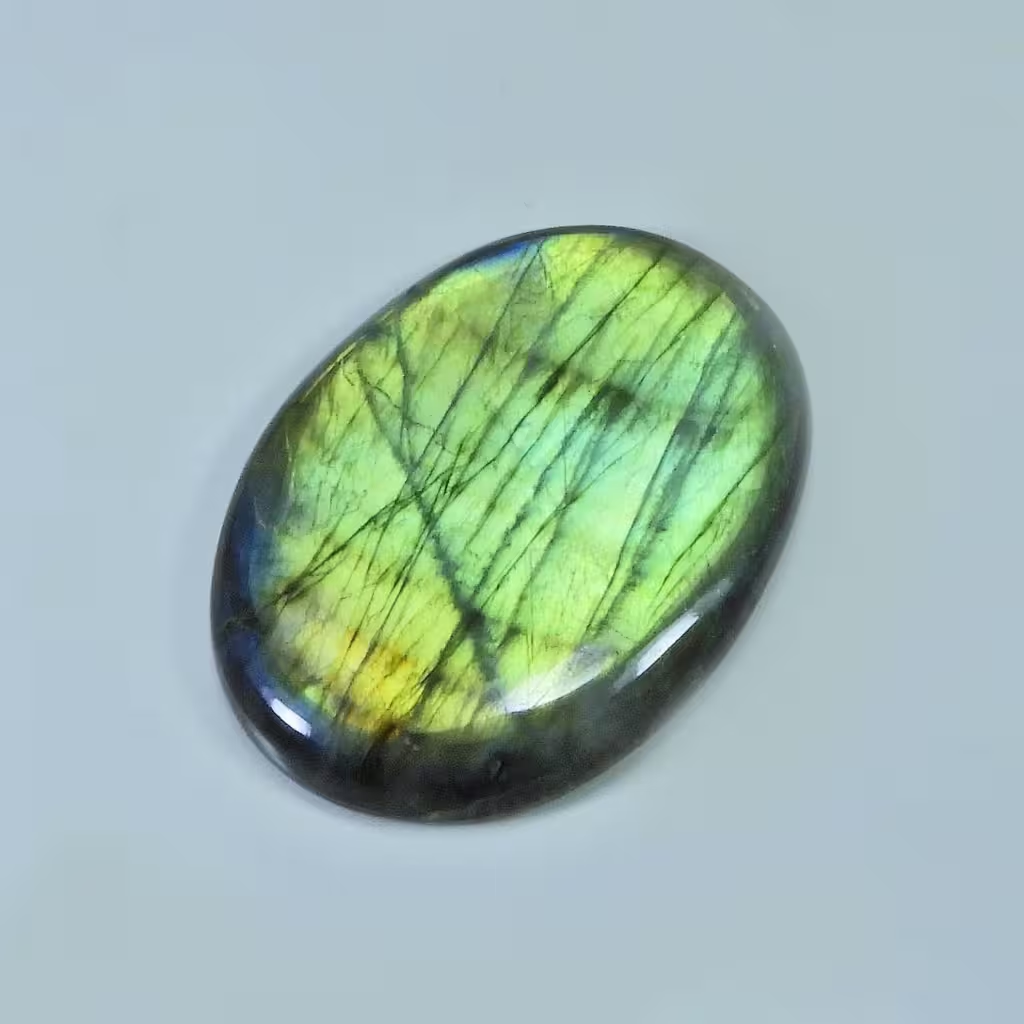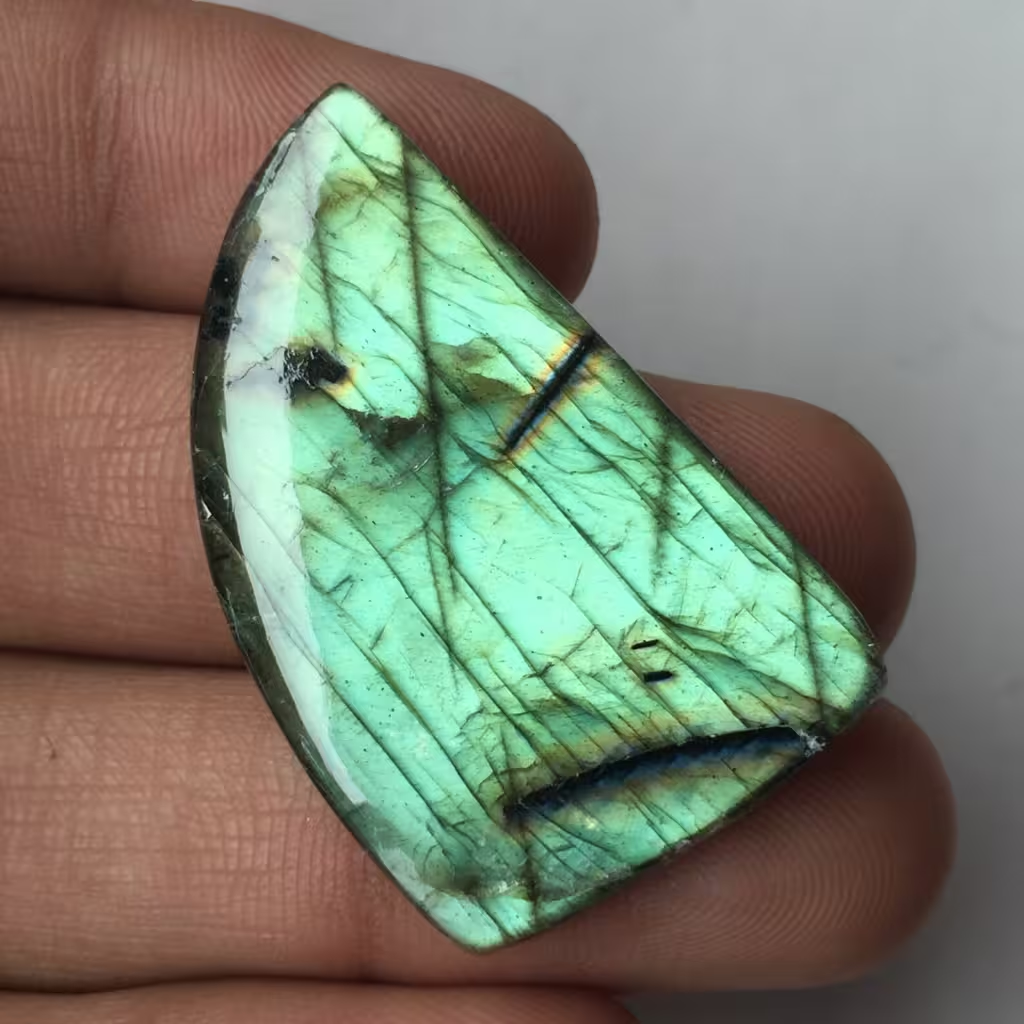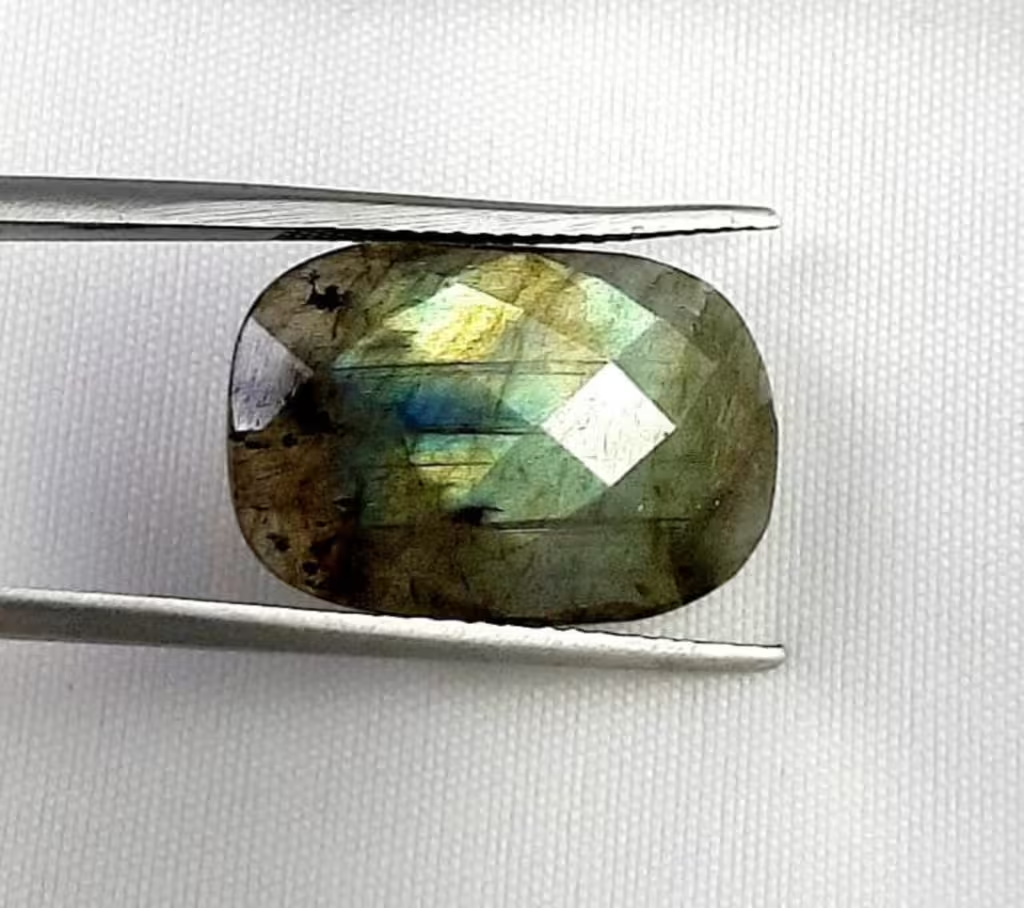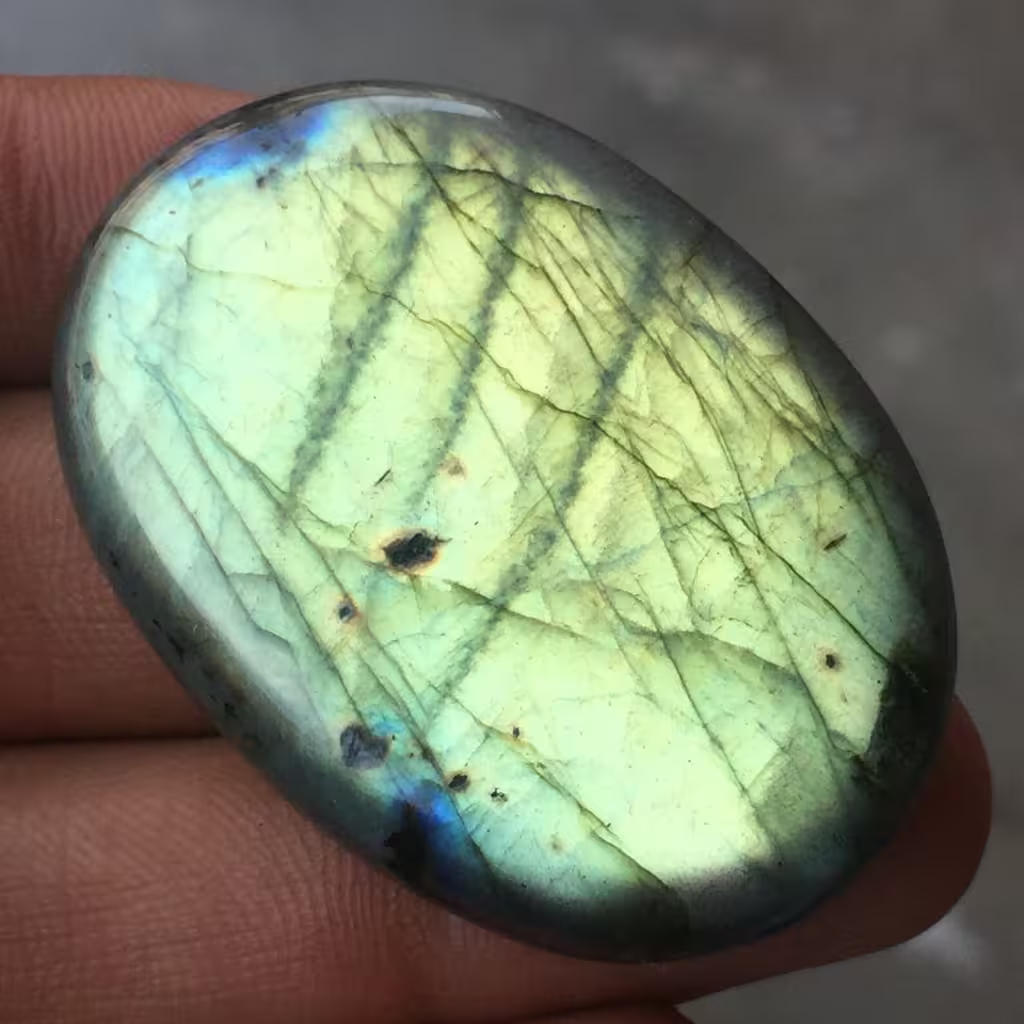Green labradorite is gemstone, known for its captivating play of colors, often referred to as labradorescence. This phenomenon is caused by the diffraction of light within the stone, which creates a shimmering effect in hues of green, blue, and sometimes yellow. Labradorite itself is a feldspar mineral, typically found in igneous rocks, and is prized for its aesthetic appeal in jewelry and ornamental pieces.

Green labradorite stands out for its predominant green hue, which can range from pale to deep, mossy tones. The stone’s color is attributed to the presence of specific trace elements and internal structures that reflect and scatter light. Green labradorite is often polished and used in various forms of jewelry, including pendants, rings, and bracelets, making it a popular choice for those who appreciate unique and eye-catching gemstones.
Historical Significance and Uses:
Labradorite was first discovered in the 18th century on the Isle of Paul, near Nain in Labrador, Canada, from which it derives its name. The indigenous Inuit people of the region believed that the stone contained the northern lights, or aurora borealis, which were thought to have been trapped within the stone by a mighty force. This mythological connection contributed to the stone’s mystical reputation.
Historically, labradorite, including its green variety, has been used for its metaphysical properties. It is believed to provide protection, enhance intuition, and promote self-discovery. These qualities have made it a popular stone among spiritual practitioners and healers.
In addition to its metaphysical uses, green labradorite has also been valued for its beauty and durability in various cultures. It has been carved into talismans, amulets, and other decorative objects, symbolizing transformation and spiritual growth. Today, it continues to be cherished not only for its unique visual appeal but also for the deeper meanings and energies it is believed to hold.
Contents
Formation and Geological Background of Green Labradorite

Geological Environment and Conditions for Formation:
Green labradorite, like other forms of labradorite, is a member of the plagioclase feldspar group, which forms in igneous rocks. Its formation typically occurs in the cooling magma of intrusive igneous environments, such as within the earth’s crust. The specific conditions required for labradorite formation include a high concentration of calcium and sodium, which are key components of the feldspar mineral group.
During the cooling process, labradorite crystals develop, often in conjunction with other minerals like pyroxenes and olivine. The unique labradorescence seen in green labradorite is a result of microscopic lamellar structures within the crystal, which create interference patterns as light passes through the stone. These internal structures are formed due to slow cooling, which allows the different components of the feldspar to separate into layers, enhancing the stone’s optical effects.
Plate Tectonics and Geological Processes Involved:
The formation of labradorite is closely linked to tectonic activity, particularly in regions where the earth’s crust is being pulled apart or subducted. Green labradorite often forms in areas of significant tectonic activity, such as mid-ocean ridges, where magma rises from the mantle and solidifies to form new oceanic crust. This environment provides the ideal conditions for the formation of labradorite-rich gabbros and anorthosites, which are common host rocks for labradorite.
Subduction zones, where one tectonic plate is forced beneath another, can also create the necessary conditions for labradorite formation. The intense pressure and temperature changes in these zones can lead to the crystallization of labradorite in the deep crust, particularly in areas with abundant mafic magma.
Key Regions Where Green Labradorite Is Found:
Green labradorite can be found in several regions around the world, often in areas associated with ancient or active tectonic activity. Some of the most notable locations include:
- Labrador, Canada: The original discovery site of labradorite, this region remains a significant source of the stone. The labradorite found here often exhibits a wide range of colors, including green, due to the varied geological conditions.
- Madagascar: Known for producing some of the finest quality labradorite in the world, Madagascar is a key source of green labradorite. The stones from this region are highly sought after for their intense color and vibrant labradorescence.
- Russia: Particularly in the Ural Mountains, labradorite deposits are found in association with ancient igneous rocks. The labradorite from this region is often used in both jewelry and decorative art.
- United States: States like Oregon and Utah have significant labradorite deposits, where the stone is found in association with volcanic rocks. The green labradorite from these regions is often used in jewelry and as a collector’s gemstone.
These regions are characterized by their geological diversity, providing the specific conditions necessary for the formation of labradorite, including its green variety. The presence of tectonic activity, both ancient and current, plays a crucial role in the formation and distribution of this beautiful gemstone.
Mineralogical Properties of Green Labradorite

Chemical Composition (Primarily Feldspar Group):
Green labradorite belongs to the plagioclase feldspar group, a series of tectosilicate minerals that form a solid solution between albite (sodium-rich) and anorthite (calcium-rich). The chemical formula for labradorite typically falls between these two end-members and can be expressed as (Na,Ca)(Al,Si)₄O₈.
In green labradorite, the presence of specific trace elements, such as iron, can influence the overall coloration, contributing to the green hue. The calcium content is generally higher than in albite, making labradorite more calcium-rich. The balance between sodium and calcium in the crystal lattice, along with the presence of other trace elements, determines the exact characteristics and color variations of the stone.
Crystallography and Crystal Structure:
Labradorite crystallizes in the triclinic system, meaning it has three unequal axes that are not at right angles to each other. The crystal structure of labradorite is complex, consisting of a framework of silicon-oxygen tetrahedra. This framework creates a three-dimensional network that includes both aluminum and silicon atoms, with sodium and calcium atoms occupying specific positions within this framework.
One of the most distinctive features of labradorite is the presence of twinning planes within its crystal structure. These planes, known as polysynthetic twinning, occur due to the repeated stacking of crystal layers in a specific manner during formation. The twinning is a key factor in producing the optical phenomenon known as labradorescence, where light is scattered by the thin layers within the crystal, creating flashes of color.
Optical Properties (Iridescence, Labradorescence):
Green labradorite is celebrated for its unique optical properties, particularly labradorescence. This optical effect is characterized by the stone’s ability to reflect light in vibrant flashes of color, including greens, blues, and sometimes golds. The phenomenon is due to the interference of light as it passes through the microscopic layers or lamellae within the stone, which are formed by the separation of different feldspar components during cooling.
The iridescence seen in green labradorite is a form of schiller effect, where the stone exhibits a metallic sheen or glowing appearance when viewed from certain angles. This effect is most pronounced in stones with well-developed internal structures, which can enhance the scattering of light and the resulting color play.
Labradorescence is not only dependent on the internal structure but also on the angle and intensity of the light source. As the stone is moved, the colors appear to shift and change, giving green labradorite its characteristic mystical and ethereal quality. This optical property makes labradorite a highly desirable gemstone for use in jewelry, as each stone can display a unique pattern and range of colors.
In summary, the mineralogical properties of green labradorite, including its chemical composition, crystallography, and optical characteristics, all contribute to its status as a gemstone of great beauty and intrigue. Its complex structure and stunning visual effects make it a favorite among collectors and jewelry enthusiasts alike.
Physical Characteristics of Green Labradorite

Color Variations and Causes (Why It’s Green):
Green labradorite exhibits a range of colors, primarily green, but can also show hues of blue, yellow, and sometimes even a mix of these colors. The green coloration is due to the presence of trace elements and the specific arrangement of the crystal structure within the labradorite.
- Color Causes: The green in labradorite is primarily due to iron and other trace elements within the feldspar lattice. The varying concentrations of these elements can influence the intensity and shade of the green. Additionally, the specific arrangement and separation of layers within the crystal can affect how light interacts with the stone, leading to different color appearances.
- Play of Colors: The labradorescence effect, where flashes of green, blue, and other colors are visible, is influenced by the internal structure and the orientation of the crystal layers. These layers cause interference and diffraction of light, which enhances the green color and creates the vibrant play of colors seen in high-quality specimens.
Hardness and Durability:
- Hardness: Green labradorite has a hardness of approximately 6 to 6.5 on the Mohs scale. This level of hardness makes it relatively durable and suitable for use in various types of jewelry. However, it is not as hard as some other gemstones, like sapphires or diamonds, so care should be taken to avoid scratches and damage.
- Durability: The durability of green labradorite is influenced by its cleavage properties. Labradorite has perfect cleavage along two directions, which means it can split or fracture along these planes if subjected to sharp impacts or pressure. Despite this, it is generally stable and can be used in jewelry with proper care. It is advisable to protect labradorite pieces from rough handling and to avoid exposing them to harsh chemicals.
Transparency and Luster:
- Transparency: Labradorite, including its green variety, can range from transparent to opaque. High-quality specimens often exhibit translucency, allowing some light to pass through and enhancing their visual appeal. The degree of transparency can affect the intensity of the labradorescence observed.
- Luster: Green labradorite typically exhibits a vitreous or glassy luster. This luster contributes to the stone’s overall appearance and brilliance. The high luster, combined with its play of colors, makes labradorite particularly attractive for use in polished gemstones and jewelry. The luster can vary slightly depending on the quality of the polishing and the inherent properties of the stone.
In summary, green labradorite is a striking gemstone with distinctive color variations influenced by its chemical composition and internal structure. While it is moderately hard and durable, it requires careful handling to prevent damage. Its transparency and luster add to its visual appeal, making it a popular choice for collectors and jewelry enthusiasts.
Economic and Commercial Aspects of Green Labradorite

Mining Locations and Methods:
- Mining Locations: Green labradorite is extracted from several key regions around the world. Major sources include:
- Labrador, Canada: The original source of labradorite, known for its rich deposits. Mining is conducted both in open-pit and underground operations.
- Madagascar: A significant producer of high-quality green labradorite. Mining here often involves artisanal methods as well as more mechanized operations.
- Russia: Particularly in the Ural Mountains, where mining includes both large-scale and artisanal techniques.
- United States: In states such as Oregon and Utah, where labradorite is mined from volcanic rock deposits.
- Mining Methods: Mining methods vary depending on the location and scale of operations. Common methods include:
- Open-Pit Mining: Used for surface deposits, where the overburden is removed to access the labradorite-bearing rock.
- Underground Mining: Employed for deeper deposits, where shafts and tunnels are dug to reach the labradorite.
- Artisanal Mining: In some regions, small-scale miners use hand tools and basic techniques to extract the stone, which can impact the environment and lead to inconsistent quality.
Market Demand and Pricing:
- Market Demand: Green labradorite is in demand primarily for its aesthetic appeal and unique optical properties. Its vibrant colors and labradorescence make it popular in the gemstone market. The demand is driven by its use in fine jewelry, decorative items, and as a collector’s gem.
- Pricing: The price of green labradorite varies based on several factors, including:
- Quality and Color: Higher-quality stones with intense green hues and strong labradorescence command higher prices.
- Size and Cut: Larger stones and those with well-cut facets or cabochons are generally more valuable.
- Origin: Stones from well-known locations like Madagascar or Canada may fetch higher prices due to their reputation and quality.
Pricing can range from modest amounts for smaller or less vibrant stones to significant sums for high-quality, large specimens. Market trends and demand fluctuations can also affect pricing.

Uses in Jewelry and Industry:
- Jewelry: Green labradorite is commonly used in a variety of jewelry applications, including:
- Rings and Pendants: Its striking color and play of light make it a popular choice for these settings.
- Bracelets and Earrings: Often featured in designs where its optical effects can be showcased.
- Beads and Cabochons: Used in beaded jewelry or as polished cabochons in various settings.
- Industry: While not as widely used in industrial applications as some other minerals, labradorite’s unique properties have led to niche uses:
- Decorative Items: Labradorite is used in decorative carvings, ornamental objects, and as inlays in furniture or other items.
- Metaphysical and Healing Practices: The stone is valued in metaphysical and spiritual communities for its supposed healing properties, leading to its use in various holistic and decorative practices.
In summary, green labradorite has significant commercial value due to its aesthetic appeal and unique optical properties. Mining locations and methods vary, with both large-scale and artisanal approaches employed. Market demand and pricing are influenced by quality, size, and origin, while its primary uses remain in fine jewelry and decorative applications.
Cultural and Mystical Significance of Green Labradorite

Folklore and Traditional Beliefs:
- Indigenous Legends: Labradorite was first discovered in Labrador, Canada, where it was believed by the indigenous Inuit people to hold the power of the northern lights, or aurora borealis. According to Inuit legend, the lights were trapped in the stone by a great warrior who struck the earth. The stone’s shimmering play of colors was thought to be a fragment of this celestial light.
- Cultural Symbolism: In various cultures, labradorite has been associated with protection and transformation. Its unique optical effects and vibrant colors have led to its use in spiritual and ceremonial contexts. The stone has been considered a powerful talisman to ward off negative energy and to bring insight and clarity.
Modern Uses in Metaphysical Practices:
- Healing Properties: In modern metaphysical practices, labradorite is often used for its purported healing properties. It is believed to support personal transformation and spiritual growth. Practitioners claim that it helps with intuition, enhances psychic abilities, and provides a sense of inner balance. The stone is often used in meditation to help align and open the third eye chakra.
- Energy Work: Labradorite is popular in energy healing and crystal therapy. Practitioners use it to protect against negative energies and to facilitate change. It is said to help with emotional healing, stimulate the mind, and encourage self-discovery.
- Spiritual Growth: Many people use labradorite as a tool for spiritual development. It is thought to enhance one’s connection with higher realms and support personal evolution. Its labradorescence is seen as a symbol of spiritual illumination and insight.
- Amulets and Talismans: Labradorite is frequently worn as an amulet or talisman to harness its believed protective and transformative energies. It is used in various forms, including jewelry, pendants, and even as loose stones placed in sacred spaces.
While these beliefs are widely embraced in metaphysical communities, it’s important to note that they are based on tradition and personal experience rather than scientific evidence. The stone’s cultural and mystical significance continues to make it a valued gem in both historical and contemporary contexts.




































